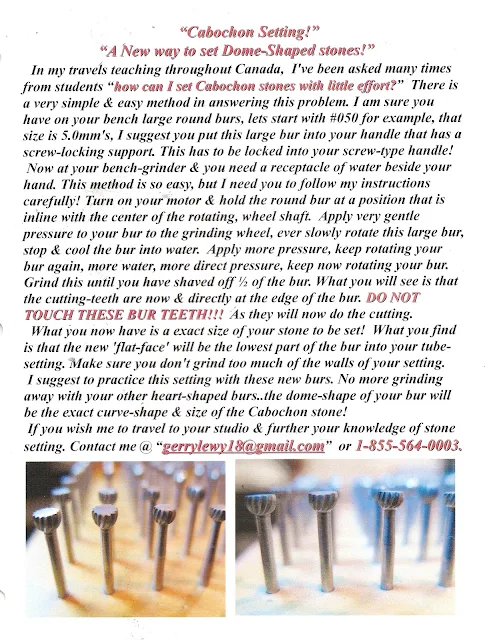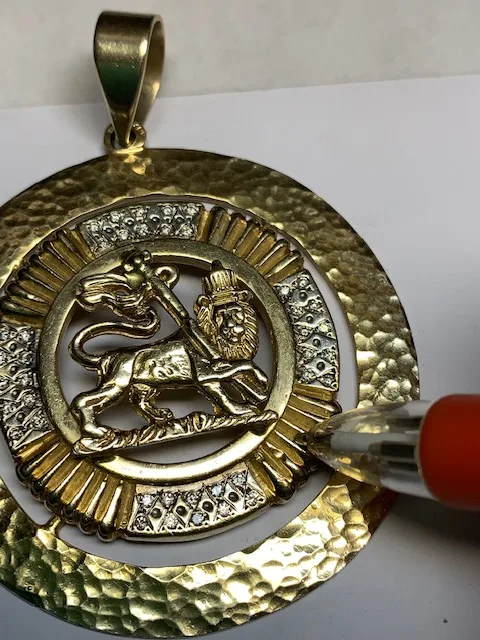This is one of those items where a setter wants to capture as many 51 photos as possible before giving this pendant back to the client. I was extremely privileged in having the opportunity in working on this fantastic item.
BTW, there were over 325 diamonds that had to be set into this pendant. And yes, I had this pendant secured on my shellac stick for stone setting. For display photo purposes only, I had it sitting on my "GRS" vice clamp.
Do you want to start counting all of the diamonds?
The gold weight for this item was not light, without the bail was 43.50 grams.
All of the intricate gold carvings were done WITHOUT the use of CAD.
The two Emeralds were the colour of grass, the two Rubies were the eyes. and Blue Sapphires stood for the colours on the flag. I set a Ruby on the Lions hat.
I was asked to put gemstones 'everywhere' and of course, I did.
For size reference, I placed this necklace on the GRS clamp.
I had to show you just how large this was on my hand, here it is! Unbelievably large.
Here is my (best friend) and wi-fi computer expert. Even he couldn't visualize the size & complexity until he held it against his chest.
After the Rhodium Plating process from my off-site Plating Jeweller. I couldn't fathom the beauty of it, in just the yellow-gold colour.
This was the original colour after my Diamond Setting was finished. I'd call this 'bland' and literally unattractive.
My client gave me this basic pattern and my mind went working on how to create something that will last for many decades.
The pen point is to show where future gemstone additions will be made.
On every section of the necklace, there would be diamonds or genuine stones.
I removed the centre section with the "Lion", as I had no intention of touching anything else.
Here you can see how I created 'claws' from a flat circle. There is 'one spot' with no drilling, that is how I created mini-claws all around this circle.
You now can see what the previous setter attempted to make this look decent, but he totally failed. His 'bead setting' is a testament to not being creative.
Do you want to count how many diamonds there are on this tray? I used every one of them in this exercise...1-2-3-4- (ad infinitum).
I was wanting to segregate the sizes of the many stones for the different sections of this ornament.
I put little dabs of oil on the circle and positioned the diamonds before drilling with my 'twist drill'. The oiled surface prevented any loss of stones during the intricate positioning.
I removed ONE STONE, then inked that spot and continued all around the circle. BTW, I turned off all of my "YouTube, Classical Opera" music and hoped that no phone calls would interrupt my intense 'train of thought'.
All of the drilling of the stone holes were now completed, thankfully!
I positioned this disk on my 'shellac stick' with no intention of using any clamping device. I needed 'underneath support' on this very thin disk at all times.
You can see how I positioned extra shellac behind and as well underneath. I wanted to have this disk RIGID all through the Pave-Bead Raising process.
I still can't believe the size and enormity of this "Piece of Wearable Art". Just a mind-boggling necklace.
This is the actual weight of this item, (without the bail).
My idea at first was to file down all of the indentations, but alas, I thought of just turning it over and using the flat surface. The reasoning would make the disk even thinner than before...Bad move, agree?
I separated the inner section of the "Lion" and the large round disk & VOILA.I carefully inked and if I chose not to accept any inked spots, I just wiped that spot clean and made sure those spots were acceptable to my 'creative' eyes.
I used a round bur to make an indentation for the 'twist drill'. Even then, I had to 'double-check' for the final spacing.
Each and every area had different sizes of diamonds to use. At the far left of my bench peg were 16 larger stones. In the centre of my bench peg were another 16 more stones, the remainder was for anywhere that I could use them.
Here is the client wearing his item before anything was started.
The reverse side showed what I was going to do with this piece of gold. I requested to let him know what my plans were at each step along this long process.
I had no idea what the original setter was thinking by drilling the round holes? Probably for decoration. OUCH?
My question is to you, the reader, what would you do differently?
Here is my pen marking any of the spots for twist drilling of the many holes.
As I don't have any experience with soldering, I gave my off-site jeweller the task of assisting me, in this delicate project. This process even included the Rhodium Plating.
I had to create in my mind a picture of where to set the genuine stones. What size, what colour and of course WHERE?
Each step had to be approved by my client, there couldn't be any arguments after the setting has been completed.
Being a Diamond Setter is not a mechanical operation, but this setter has to be a creative designer as well.























.jpg)






.jpg)

















.jpg)
.jpg)
.jpg)
.jpg)
.jpg)
.jpg)
.jpg)
.jpg)

.jpg)





.jpg)
.jpg)

.jpg)





